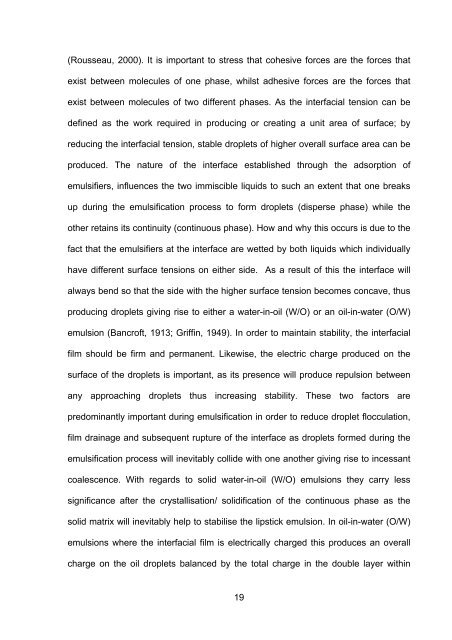Stabilisation of water-in-oil emulsions to improve - eTheses ...
Stabilisation of water-in-oil emulsions to improve - eTheses ...
Stabilisation of water-in-oil emulsions to improve - eTheses ...
Create successful ePaper yourself
Turn your PDF publications into a flip-book with our unique Google optimized e-Paper software.
(Rousseau, 2000). It is important <strong>to</strong> stress that cohesive forces are the forces that<br />
exist between molecules <strong>of</strong> one phase, whilst adhesive forces are the forces that<br />
exist between molecules <strong>of</strong> two different phases. As the <strong>in</strong>terfacial tension can be<br />
def<strong>in</strong>ed as the work required <strong>in</strong> produc<strong>in</strong>g or creat<strong>in</strong>g a unit area <strong>of</strong> surface; by<br />
reduc<strong>in</strong>g the <strong>in</strong>terfacial tension, stable droplets <strong>of</strong> higher overall surface area can be<br />
produced. The nature <strong>of</strong> the <strong>in</strong>terface established through the adsorption <strong>of</strong><br />
emulsifiers, <strong>in</strong>fluences the two immiscible liquids <strong>to</strong> such an extent that one breaks<br />
up dur<strong>in</strong>g the emulsification process <strong>to</strong> form droplets (disperse phase) while the<br />
other reta<strong>in</strong>s its cont<strong>in</strong>uity (cont<strong>in</strong>uous phase). How and why this occurs is due <strong>to</strong> the<br />
fact that the emulsifiers at the <strong>in</strong>terface are wetted by both liquids which <strong>in</strong>dividually<br />
have different surface tensions on either side. As a result <strong>of</strong> this the <strong>in</strong>terface will<br />
always bend so that the side with the higher surface tension becomes concave, thus<br />
produc<strong>in</strong>g droplets giv<strong>in</strong>g rise <strong>to</strong> either a <strong>water</strong>-<strong>in</strong>-<strong>oil</strong> (W/O) or an <strong>oil</strong>-<strong>in</strong>-<strong>water</strong> (O/W)<br />
emulsion (Bancr<strong>of</strong>t, 1913; Griff<strong>in</strong>, 1949). In order <strong>to</strong> ma<strong>in</strong>ta<strong>in</strong> stability, the <strong>in</strong>terfacial<br />
film should be firm and permanent. Likewise, the electric charge produced on the<br />
surface <strong>of</strong> the droplets is important, as its presence will produce repulsion between<br />
any approach<strong>in</strong>g droplets thus <strong>in</strong>creas<strong>in</strong>g stability. These two fac<strong>to</strong>rs are<br />
predom<strong>in</strong>antly important dur<strong>in</strong>g emulsification <strong>in</strong> order <strong>to</strong> reduce droplet flocculation,<br />
film dra<strong>in</strong>age and subsequent rupture <strong>of</strong> the <strong>in</strong>terface as droplets formed dur<strong>in</strong>g the<br />
emulsification process will <strong>in</strong>evitably collide with one another giv<strong>in</strong>g rise <strong>to</strong> <strong>in</strong>cessant<br />
coalescence. With regards <strong>to</strong> solid <strong>water</strong>-<strong>in</strong>-<strong>oil</strong> (W/O) <strong>emulsions</strong> they carry less<br />
significance after the crystallisation/ solidification <strong>of</strong> the cont<strong>in</strong>uous phase as the<br />
solid matrix will <strong>in</strong>evitably help <strong>to</strong> stabilise the lipstick emulsion. In <strong>oil</strong>-<strong>in</strong>-<strong>water</strong> (O/W)<br />
<strong>emulsions</strong> where the <strong>in</strong>terfacial film is electrically charged this produces an overall<br />
charge on the <strong>oil</strong> droplets balanced by the <strong>to</strong>tal charge <strong>in</strong> the double layer with<strong>in</strong><br />
19
















